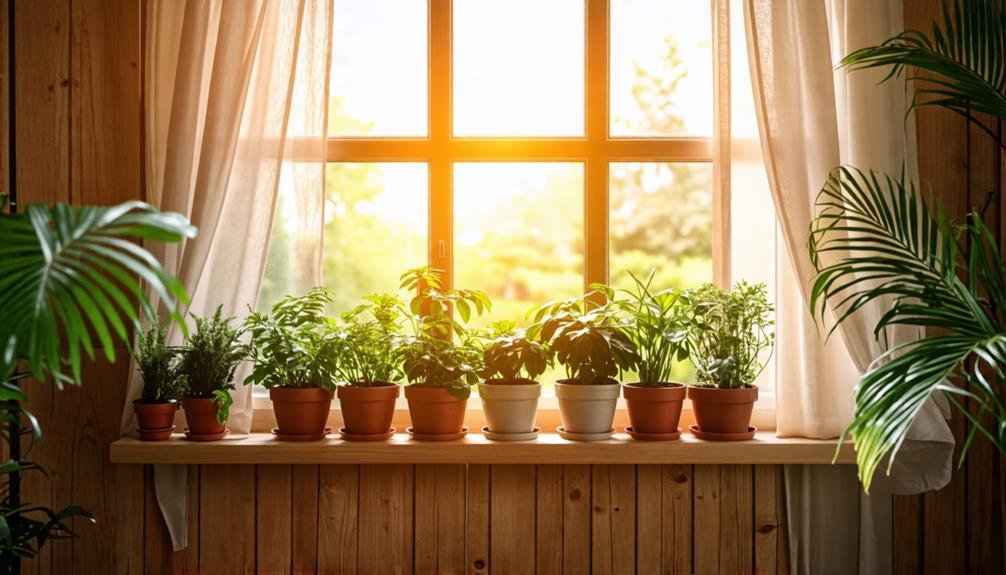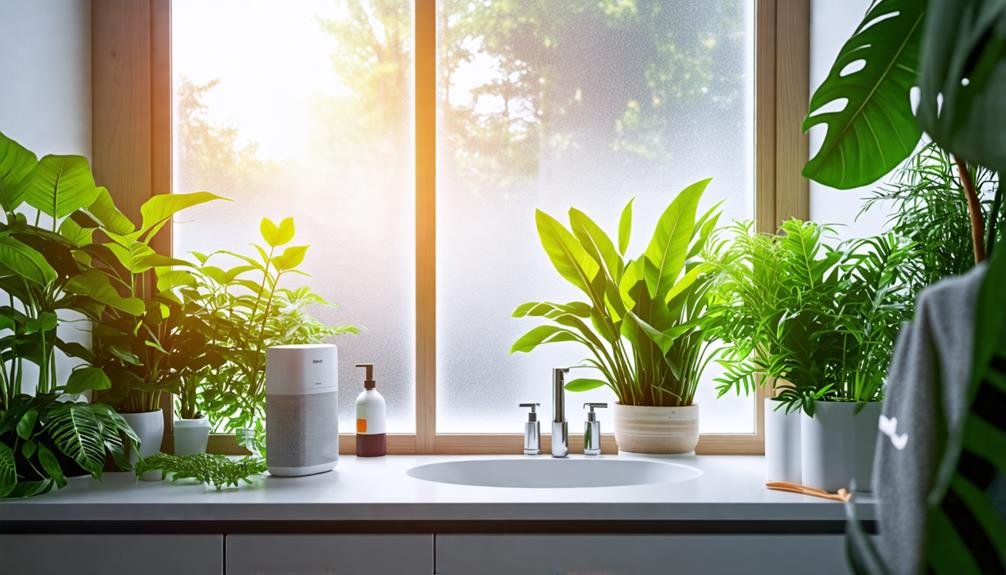To attract hummingbirds, tie vivid orange ribbons around trees in your yard. Hummingbirds are attracted to red and orange hues, linking them with nectar-filled flowers. Select sturdy ribbons that are at least 1 inch wide and 12 inches long, using materials like nylon or polyester for weather durability. Position these ribbons securely near feeders and nectar-filled blooms, ideally in open areas for maximum visibility. Timing is critical; place ribbons approximately two weeks before the hummingbirds' spring migration. Regular upkeep is fundamental to guarantee ribbons remain vibrant and appealing, boosting your chances of luring these exquisite birds to your garden environment. Insights on creating a more welcoming habitat can further enrich your success.
Understanding Hummingbird Color Preferences
Hummingbirds prefer bright colors, particularly red and orange. These vibrant hues indicate high nectar availability in flowers. Their advanced vision, capable of detecting ultraviolet light, allows them to see a wider range of colors. Consequently, flowers in shades of orange or red signal a rich food source, guiding hummingbirds during foraging.
To attract hummingbirds like the Ruby-throated Hummingbird to your garden, consider using orange ribbons as visual markers. These ribbons can lead the birds to feeders, such as those from the brand Perky-Pet, and flowering plants. Ensure the ribbons are easily visible from a distance for maximum effectiveness.
Incorporating these strategies not only enhances the beauty of your outdoor space but also fosters a welcoming habitat for these remarkable creatures. By understanding hummingbird color preferences, you can design your garden to encourage their return year after year. Such efforts contribute to a vibrant ecosystem, celebrating the freedom and beauty of nature.
How to Use Orange Ribbons
To effectively attract hummingbirds, it is crucial to select the correct orange ribbons and implement strategic placement for maximum visibility. Durable materials, such as orange surveyors tape, should be utilized and affixed in areas that guide these birds to food sources. Moreover, seasonal upkeep, including timely installation and removal of ribbons, guarantees that your yard stays an inviting habitat for these vibrant visitors.
Choosing the Right Ribbons
Choosing durable orange ribbons that can withstand outdoor conditions is vital for attracting hummingbirds to your garden. The right ribbon enhances visibility, sending a clear signal to these vibrant birds. When selecting your ribbons, keep in mind these important aspects:
- Material Strength: Select weather-resistant options like nylon or polyester, which resist fading and fraying in various outdoor environments.
- Size and Length: Go for ribbons that are a minimum of 1 inch wide and cut them into 12-inch strips; this size is easily noticeable to hummingbirds from afar.
- Color Intensity: Make sure the orange is bright and reflective; this vividness will draw the attention of hummingbirds, indicating the availability of nectar-rich plants nearby.
- Securing Method: Employ strong knots or ties to attach the ribbons around tree trunks, fences, or posts, ensuring they stay put during windy or rainy weather.
Placement Strategies for Visibility
Strategic placement of bright orange ribbons is crucial for attracting hummingbirds to your garden. Use durable materials like orange surveyor's tape to ensure resilience against weather conditions. Cut sections of 12 inches and tie them securely around noticeable tree trunks, porch posts, and decorative planters. Position these ribbons near hummingbird feeders or nectar-rich flowers, effectively directing the birds to vital food sources.
For optimal visibility, choose open areas that are easily seen from various angles, steering clear of dense shrubbery that may hide the ribbons. Take into account the migration patterns of hummingbirds; hang the ribbons before their spring return to signal food availability immediately. The vivid orange hue serves as a beacon, enticing these colorful birds to your sanctuary.
Seasonal Maintenance Tips
Maintaining the visibility and integrity of vibrant orange ribbons during the hummingbird season is essential for attracting these beautiful birds to your garden. To ensure the ribbons remain effective and appealing, follow these seasonal maintenance tips:
- Routine Checks: Regularly inspect the ribbons for any signs of damage, particularly after intense weather conditions. Replace any worn or torn ribbons immediately to keep them visible.
- Strategic Positioning: Secure the ribbons around noticeable features such as oak tree trunks and wooden fences. Adjust their locations as necessary to enhance visibility from multiple perspectives.
- Update Ribbons: At the start of each season, swap out any faded ribbons for bright, new ones. This simple update can significantly boost their appeal to hummingbirds.
- End-of-Season Care: As the hummingbird season concludes, carefully take down the ribbons and store them in a dry area. This will safeguard them from harsh conditions and prepare them for next year's setup.
Timing for Ribbon Placement

Timing is essential when placing ribbons to attract hummingbirds, as their migration patterns dictate when they will return to your area. To optimize effectiveness, it is advisable to monitor these patterns closely and prepare before spring arrives, ensuring that ribbons are visible and strategically placed near food sources. Moreover, be mindful of seasonal removal guidelines to maintain an inviting environment for these birds throughout the year.
Monitor Migration Patterns
To effectively draw hummingbirds to your garden, it is crucial to observe their migration behaviors, ensuring that bright orange streamers are positioned before their spring arrival. Recognizing these behaviors enables you to prepare your flowerbeds efficiently, increasing your likelihood of attracting these beautiful birds. Here are four essential steps to assist you in timing your streamer placement:
- Investigate Migration Timelines: Learn about the standard migration timelines of hummingbird species in your area, as these can differ depending on location and weather patterns.
- Monitor Climate Conditions: Observe weather changes, as unexpected fluctuations can influence migration paths and schedules.
- Establish a Schedule: Create a planner highlighting significant dates in spring when hummingbirds are predicted to arrive, helping you to organize streamer placement strategically.
- Follow Local Sightings: Participate in local ornithology groups or digital forums to receive updates on recent hummingbird sightings, offering valuable information about their arrival timing.
Pre-Spring Preparation Tips
As you prepare for the arrival of ruby-throated hummingbirds in spring, a well-timed plan for ribbon placement can significantly enhance your garden's attractiveness to these beautiful creatures. Timing is essential; studies show that many hummingbird species, including Archilochus colubris, begin their migration in early spring, typically returning to familiar feeding grounds between mid-March and early April. To maximize your chances, it is wise to hang bright orange surveyor's tape about two weeks before the anticipated return of the hummingbirds.
Using durable orange surveyor's tape, cut into 12-inch strips, creates a noticeable signal for the birds. Securely tie these ribbons around tree trunks, porch posts, and other eye-catching spots in your yard. Additionally, placing ribbons near feeders, such as those from the Perky-Pet brand, enhances visibility, effectively guiding the birds to crucial food sources.
Keeping an eye on local migration patterns will help refine your timing; consider checking online resources or contacting local wildlife organizations for specific dates relevant to your area. By ensuring that your ribbons are installed ahead of their return, you cultivate an inviting habitat that attracts these vibrant visitors, leading to a delightful springtime experience.
Seasonal Removal Guidelines
To ensure a tidy and safe environment for your yard, remove decorative ribbons after the hummingbird migration concludes, typically by late fall. This timing enhances the visual appeal of your landscape and protects these fragile avians during their journey.
To effectively manage ribbon usage, follow these tips:
- Observe Migration Trends: Track local hummingbird migration patterns to know when to hang ribbons in early spring.
- Seasonal Duration: Keep ribbons displayed throughout the hummingbird season, which spans from spring to late fall.
- Prompt Late Fall Removal: Take down ribbons promptly after the hummingbirds have migrated south, usually by late October to early November.
- Store for Future Use: Keep ribbons in a dry location to avoid wear and tear, ensuring they are ready for next spring's installation.
Creating a Hummingbird-Friendly Environment
Creating a hummingbird-friendly garden involves incorporating bright colors, food sources, and safe resting areas that meet their specific needs. Bright hues, especially orange and red, attract these small birds, as they are drawn to nectar-rich flowers. You can enhance your yard by hanging colorful ribbons, which guide hummingbirds to food sources, particularly during their migration seasons.
In addition to visual lures, it's essential to offer a variety of food options. Hummingbird feeders, such as those from the brand Perky-Pet, should be filled with a solution of four parts water and one part sugar, replicating the natural nectar they seek. Including flowering plants like begonias and trumpet vines not only provides nourishment but also beautifies your outdoor space.
Furthermore, creating safe resting spots is vital for their security. Position feeders at least five feet above the ground to protect them from predators while allowing easy access to foliage for shelter. By cultivating an inviting environment that combines vibrant colors, plentiful food, and secure resting areas, you will support a thriving habitat for hummingbirds to flourish and enjoy their freedom.
Safety Tips for Hummingbirds

To ensure a safe habitat for hummingbirds, it's crucial to address their unique requirements and the dangers they may encounter in your garden. By adopting thoughtful safety practices, you can create an inviting environment for these extraordinary creatures. Here are four essential safety recommendations:
- Elevate Feeders: Hang hummingbird feeders, such as the Perky-Pet Hummingbird Feeder, at least five feet above ground. This height minimizes the chance of predation from domestic cats and other threats.
- Strategic Placement: Avoid positioning feeders near branches that facilitate predator access. Instead, place them near dense shrubs or bushes, providing quick escape routes for the birds.
- Water Sources: Install a shallow birdbath, like the Wild Bird Products Birdbath, to offer a reliable water source. This addition not only attracts hummingbirds but also encourages their regular visits.
- Regular Maintenance: Ensure your feeders, such as the First Nature Hummingbird Feeder, are clean and filled with fresh sugar water. Consistent upkeep fosters a healthy and welcoming environment for these avian visitors.
Maintaining Your Hummingbird Setup
Regular upkeep of your hummingbird setup is crucial to ensure a steady supply of nourishment and a safe habitat for these fragile avians. Start by routinely cleaning your hummingbird feeders, such as those made by Perky-Pet or Aspects, to prevent mold and harmful bacteria from developing. Rinse the feeders with hot water and refill them with fresh sugar water in a 4:1 ratio, providing optimal sustenance. It's recommended to change the nectar every three to five days, particularly during warmer months, to keep it fresh.
Additionally, keep an eye on the vibrant orange ribbons tied around your trees. These colorful indicators attract hummingbirds; ensure they remain bright and undamaged. If the ribbons appear worn, replace them to maintain their effectiveness. Planting a diverse array of hummingbird-friendly blooms, like fuchsia or trumpet vine, can further enhance the appeal of your garden.
Lastly, include a birdbath or a shallow water source, as hydration is essential for these birds. Position feeders at least five feet above the ground to safeguard hummingbirds from predators. By following these maintenance practices, you can create a nurturing sanctuary that fosters the well-being and joy of hummingbirds in your outdoor space.


















You must be logged in to post a comment Login